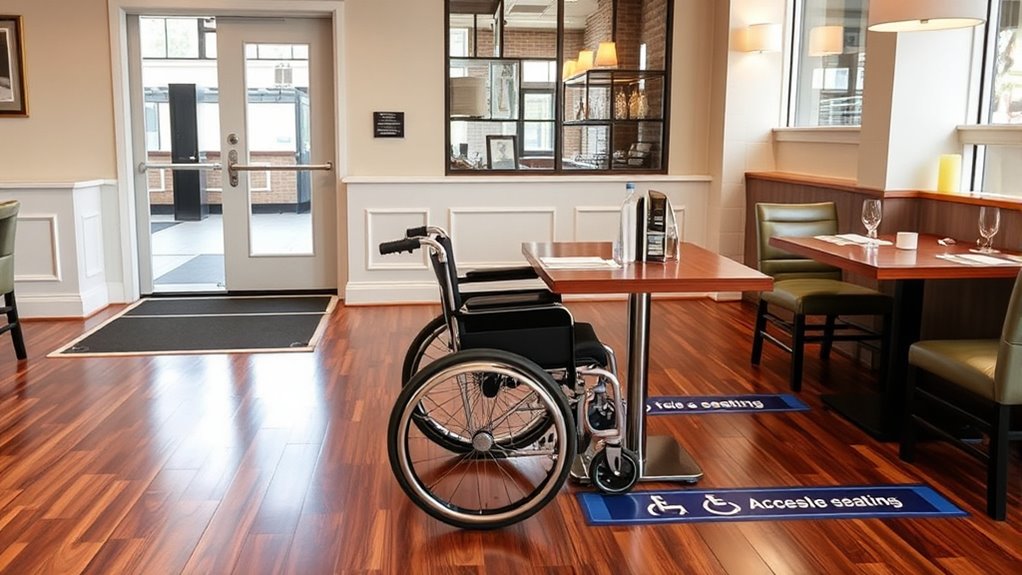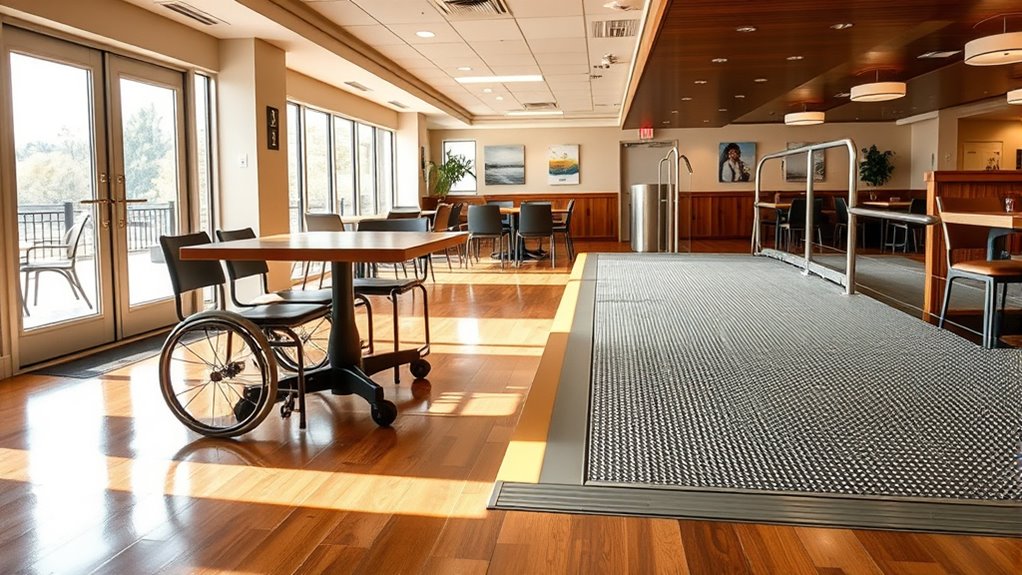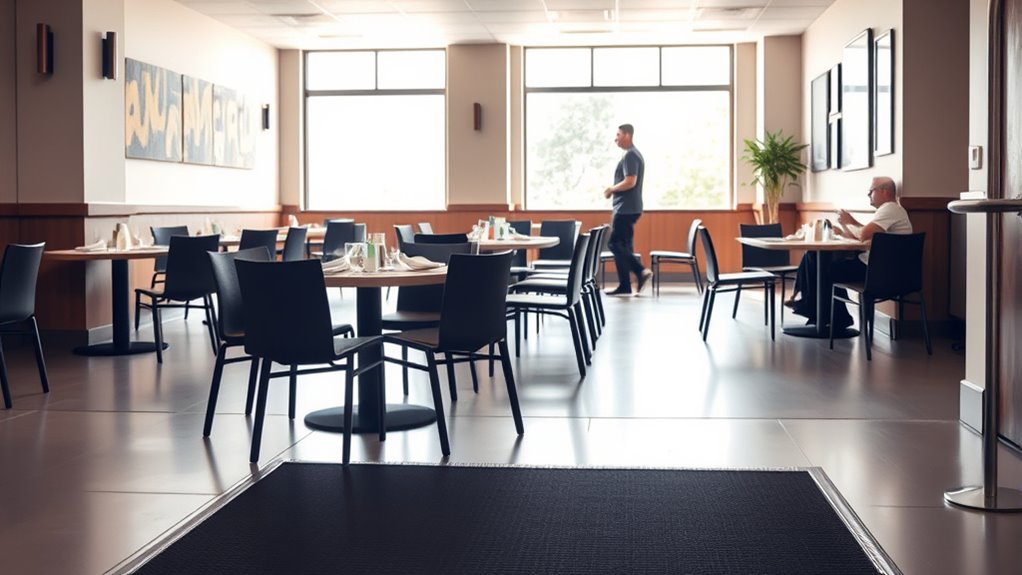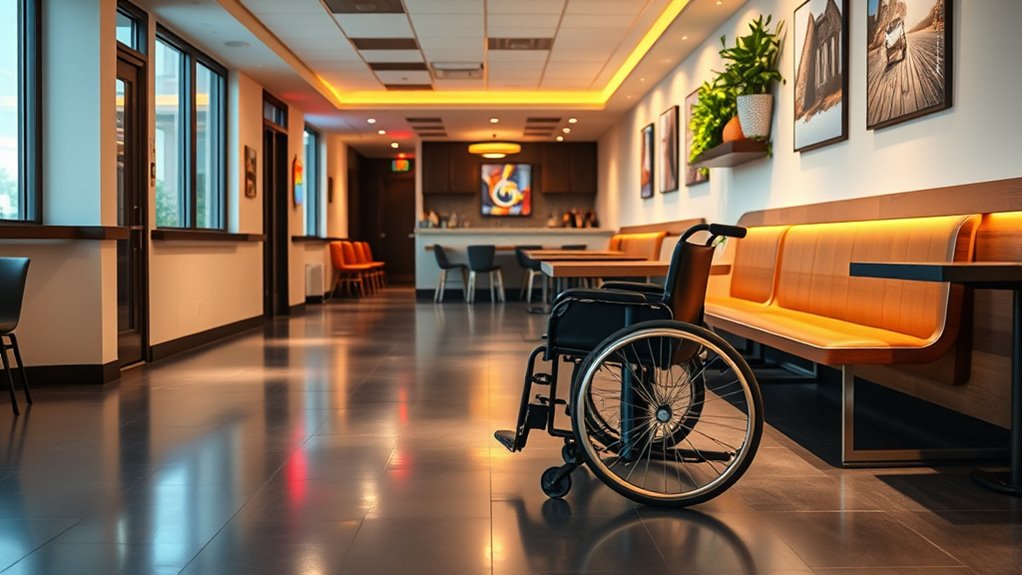To guarantee your dining room meets ADA standards, start with a thorough accessibility audit. Check that pathways are at least 36 inches wide, tables have proper knee clearance, and entrances are accessible. Look for barriers like narrow doorways or improperly placed signage, and involve staff and customers for feedback. Regularly review and update your space to maintain compliance. Keep exploring to discover detailed tips on making your dining area inclusive and welcoming for everyone.
Key Takeaways
- Conduct a thorough walkthrough to identify physical barriers such as narrow pathways, obstructed entrances, or inaccessible seating areas.
- Verify that pathways, door handles, and fixtures meet ADA width, height, and reach range requirements.
- Assess table heights, knee clearance, and accessible seating options to ensure compliance with ADA standards.
- Review signage for visibility, readability, and proper placement, including Braille where necessary.
- Engage staff and customers for feedback, document findings, and implement necessary modifications to maintain accessibility compliance.
Understanding ADA Requirements for Dining Spaces

To guarantee dining areas are accessible, understanding the key ADA requirements that apply is essential. You need to ensure the space allows ease of movement for all guests, including those with disabilities. This means providing clear paths at least 36 inches wide and accessible routes to entrances, exits, and seating areas. Tables must be designed with knee and toe clearance to accommodate wheelchair users, typically 27 inches high with enough space underneath. Restrooms and service stations should be reachable and usable, with controls and fixtures within accessible reach ranges. Signage must be clear, with Braille where necessary. Familiarizing yourself with these standards helps you create an inclusive environment that meets legal requirements and enhances the dining experience for everyone. Additionally, understanding accessible design principles can help you optimize the layout for both safety and comfort.
Conducting a Comprehensive Accessibility Walkthrough

Conducting a thorough accessibility walkthrough is a critical step in ensuring your dining space meets ADA standards. You’ll systematically examine every area, from entrance to seating, to identify potential barriers. Focus on clear pathways, door widths, and accessible routes that allow easy movement for all guests. Check the height and placement of tables, ensuring enough knee clearance, and verify if signage is visible and easy to read. Look for obstacles that could hinder wheelchair users or individuals with mobility aids. Walk through the space as if you’re a guest with different needs, noting any issues. Keep these key points in mind:
Perform an accessibility walkthrough to identify barriers and ensure your dining space meets ADA standards.
- Pathway widths and free of obstructions
- Accessible door handles and thresholds
- Clear signage and wayfinding aids
- Table heights and knee space
- Restroom accessibility features
Identifying and Addressing Common Barriers

After completing your accessibility walkthrough, it’s time to pinpoint common barriers that may still hinder guests with disabilities. Look for obstacles like narrow doorways, uneven flooring, or tightly spaced tables that limit movement. Check if signage is clear and properly positioned for visibility and readability. Verify that seating options include accessible tables and that there’s enough clearance underneath for wheelchair users. Identify any visual or auditory cues that might be confusing or inaccessible. Address issues by rearranging furniture, widening pathways, or adding ramps where needed. Removing these barriers improves the dining experience for all guests and guarantees compliance with ADA standards. Being thorough in this step helps you create an inclusive environment where everyone can enjoy your dining room comfortably. Additionally, understanding the different types of ADA Accessibility Audits ensures your establishment meets all necessary requirements.
Engaging With Stakeholders During the Audit Process

Engaging with stakeholders during the audit process is crucial for identifying practical solutions and gaining support for accessibility improvements. When you involve staff, customers, and management, you gain insight into real-world challenges and foster buy-in. This collaboration ensures everyone understands the importance of accessibility and helps uncover overlooked barriers. Moreover, applying creative practice techniques can facilitate innovative solutions and encourage open-mindedness during discussions. To facilitate effective engagement, consider:
- Holding informal discussions with staff to gather their observations
- Surveying diners for feedback on accessibility concerns
- Scheduling meetings with management to align on goals
- Observing customer interactions to identify unnoticed issues
- Providing clear explanations of audit findings to encourage cooperation
Implementing Improvements and Maintaining Compliance

Implementing improvements and maintaining compliance require a proactive approach to guarantee accessibility standards are consistently met. You should regularly review audit findings and prioritize updates based on urgency and impact. Keep detailed records of modifications and make sure they meet ADA guidelines. Educate staff about accessibility requirements and encourage ongoing training to foster a culture of compliance. Conduct periodic re-evaluations to identify new issues or areas for enhancement. Staying informed about updates to ADA standards ensures you adapt your dining space accordingly. Keep communication open with stakeholders, including clients and employees, to gather feedback and address concerns promptly. By continuously monitoring and updating your practices, you ensure your dining room remains accessible, welcoming, and compliant with ADA regulations. Additionally, incorporating regular maintenance and inspections helps prevent potential accessibility issues before they arise.
Frequently Asked Questions
How Often Should ADA Accessibility Audits Be Conducted for Dining Rooms?
You should conduct accessibility audits regularly to verify compliance and a welcoming environment. Typically, it’s recommended to review your dining room accessibility at least once a year, especially if there are renovations or changes in layout. Additionally, after any significant modifications or if you notice potential barriers, perform an audit promptly. Staying proactive helps you meet legal requirements and provides an inclusive experience for all guests.
What Are Typical Costs Associated With ADA Compliance Renovations?
Imagine transforming your dining space, but wonder about the costs involved. Typically, ADA compliance renovations can range from a few thousand dollars for simple adjustments to over $50,000 for extensive overhauls. Factors like existing conditions, size, and specific accessibility needs influence these costs. You might find surprises along the way, but planning ahead guarantees you budget wisely, creating an inclusive environment that welcomes everyone without breaking the bank.
Are There Specific ADA Guidelines for Outdoor Dining Areas?
You wonder if there are specific ADA guidelines for outdoor dining areas. Yes, there are. You need to guarantee pathways are wide enough, at least 36 inches, and free of obstructions. Tables should have knee clearance of at least 27 inches high and 30 inches wide. Accessible routes must connect all seating areas, and surfaces should be stable and slip-resistant. Following these guidelines helps make outdoor dining welcoming and compliant for everyone.
How Can Small Businesses Afford ADA Accessibility Upgrades?
You might wonder how small businesses can afford ADA accessibility upgrades. Start by prioritizing the most critical improvements, like ramps and accessible tables, which can often be done gradually. Look for grants, tax credits, or local funding programs designed to assist small businesses with accessibility updates. Partner with community organizations or advocacy groups that may offer support or discounts, making compliance more manageable without overwhelming your budget.
What Are Penalties for Non-Compliance With ADA Standards?
Think of non-compliance as sailing into stormy waters without a life jacket. If you ignore ADA standards, you risk hefty fines, lawsuits, and damage to your reputation. Penalties can include thousands of dollars in fines, required modifications, and legal fees. You might also face court orders to fix violations promptly. Staying compliant keeps your business afloat, protecting you from costly penalties and ensuring everyone can enjoy your space safely.
Conclusion
By conducting thorough ADA accessibility audits, you guarantee your dining space welcomes everyone. Did you know that nearly 1 in 4 adults in the U.S. has a disability? Addressing barriers not only complies with regulations but also boosts your business’s inclusivity. Regular audits help you stay compliant and create a welcoming environment. Stay proactive, engage stakeholders, and keep accessibility at the forefront—your efforts make a real difference in serving all guests.









